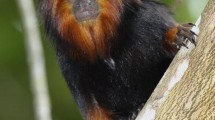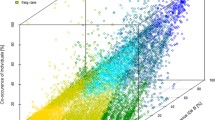Abstract
During one year, we radiotracked two female and two male Molina’s hog-nosed skunksConepatus chinga (Molina, 1782), a little studied mephitid, in the Pampas of central Argentina, to analyze the static and dynamic interactions between individuals. Mean home range overlap was large (44.5%), but males shared a smaller proportion of their home ranges than females. The average percentage of localizations in the overlap area (39.3%) indicates that these areas were not marginal sections of individual home ranges, but this value was greater for individuals of different genders than intrasexual dyads. The Coefficient of Spatial Association confirmed that the distances between individuals of different sexes were smaller than between animals of the same sex. During simultaneous locations, females were closer than males, but reciprocal distances between individuals varied over the time. These patterns are congruent with those described as typical for mustelids and mephitids. Our results confirm that an analysis of home range overlap should not be considered complete without the study of dynamic interactions among individuals and their temporal variations, which are necessary to overcome the limitations of spatial overlap analysis.
Similar content being viewed by others
References
Bixler A. and Gittleman J. L. 2000. Variation in home range size and habitat use in the Striped Skunk (Mephitis mephitis). Journal of Zoology, London 251: 525–533.
Cabrera A. L. 1976. Regiones Fitogeográficas Argentinas/Enciclopedia Argentina de Agricultura y Jardinería, Tomo 2, Fascículo 1. Acmé Editorial Buenos Aires: 1–85.
Donadio E., Di Martino S., Aubone M. and Novaro A. J. 2001. Activity patterns, home-range and habitat selection of the common hog-nosed skunk,Conepatus chinga (Mammalia, Mustelidae), in northwestern Patagonia. Mammalia 65: 49–54.
Doncaster C. P. and Macdonald D. W. 1997. Activity patterns and interactions of red foxes (Vulpes vulpes) in Oxford city. Journal of Zoology, London 241: 73–87.
Eisenberg J. 1986. Life history strategies of the Felidae: variations on a common theme. [In: Cats of the world: biology, conservation and management. S. D. Miller and D. D. Everett, eds]. National Wildlife Federation, Washington, D.C.: 293–303.
Ferreras P., Beltrán J. F., Aldama J. I. and Delibes M. 1997. Spatial organization and land tenure system of the endangered Iberian Lynx (Lynx pardinus). Journal of Zoology, London 243: 163–189.
Fournier P., Maizeret C., Fournier-Chambrillon C., Ilbert N., Aulagnier S. and Spitz F. 2008. Spatial behaviour of European minkMustela lutreola and polecatMustela putorius in southwestern France. Acta Theriologica 53: 343–354.
Frangi J. L and Bottino O. J. 1995. Comunidades vegetales de la Sierra de la Ventana, provincia de Buenos Aires, Argentina. Revista Facultad Agraria La Plata 71: 93–133.
Freer R. A. 2004. The spatial ecology of the Güiña (Oncifelis guigna) in Southern Chile. PhD thesis, University of Durham, Durham: 1–219.
Gittleman J. L. and Harvey P. H. 1982. Carnivore home-range size, metabolic needs and ecology. Behavioural Ecology and Sociobiology 10: 57–63.
Harrington L. A. and Macdonald D. W. 2008. Spatial and temporal relationship between invasive American mink and native European polecats in southern United Kingdom. Journal of Mammalogy 89: 991–1000.
Johnson D. D. P., Macdonald D. W. and Dickman A. J. 2000. An analysis and review of models of the sociobiology of theMustelidae. Mammal Review 30: 171–196.
Kenward E. E. and Hodder K. H. 1996. RANGES V. An analysis system for biological location data. Programme The Home Range, Version 1.5.
Kruuk H. and Macdonald D. W. 1985. Group territories of carnivores: empires and enclaves. [In: Behavioral ecology. R. M. Sibly and R. H Smith, eds]. Blackwell Scientific Publications, Oxford: 531–536.
Luengos Vidal E., Lucherini M. and Casanave E. 2003. An evaluation of three live traps for capturing Pampas fox. Canid News 6: 1–9.
Macdonald D. W. 1983. The ecology of carnivore social behavior. Nature 301: 379–384.
Nams V. 1990. Locate II user’s guide. Pacer Computer Software, Truro, Nova Scotia, Canada.
Powell R. A. 1979. Mustelid spacing patterns: variations on a theme byMustela. Zeitschrift für Tierpsychologie 50: 153–165.
Powell R. A. 2000. Animal home ranges and territories and home range estimation. [In: Research techniques in animal ecology. Controversies and consequences. L. Boitani and T. K. Fuller, eds]. Columbia University Press, New York: 65–110.
Redford K. and Eisenberg J. F. 1992. Mammals of the Neotropics. The Southern Cone. Vol II. Chicago University. Press, Chicago: 1–430.
Rogers L. L. 1977. Social relationships, movements, and populations dynamics of black bears in Northeastern Minnesota. PhD thesis, University of Minnesota, Minneapolis: 1–194.
Rosatte R. and Lariviere S. 2003. Skunks. [In: Wild mammals of North America: Biology, management and conservation. G. Fledhamer, B. C. Thompson and J. A. Chapman, eds]. John Hopkins University Press, Baltimore, Maryland: 692–707.
Salvatori V., Vaglio-Laurin G., Meserve P. L., Boitani L. and Campanella A. 1999. Spatial Organization, Activity, and Social Interactions of Culpeo Foxes (Pseudalopex culpaeus) in North-Central Chile. Journal of Mammalogy 80: 980–985.
Sandell M. 1989. The mating tactics and spacing patterns of solitary carnivores. [In: Carnivore behavior, ecology, and evolution. Vol. 1. J. L. Gittleman, ed]. Cornell University Press, Cornell, N.Y.: 164–182.
Seaman D. F. and Powel R. A. 1996. An evaluation of the accuracy of Kernel density estimators for home range analysis. Ecology 77: 2075–2085.
Travaini A., Delibes M. and Ceballos O. 1998. Summer foods of the Andean hog-nosed skunk (Conepatus chinga) in Patagonia. Journal of Zoology, London 246: 457–460.
USAID (ed). Biodiversity Support Program, Conservation International, The Nature Conservancy, Wildlife Conservation Society, World Resource Institute, and World Wildlife Fund 1995. A regional analysis of geographic priorities for biodiversity conservation in Latin America and the Caribbean. Biodiversity Support Program, Washington, D.C.: 1–55.
White G. C and Garrot R. A., 1990. Analysis of wildlife radiotracking data. Academic Press, New York: 1–383.
Worton B. J. 1989. Kernel methods for estimating the utilization distribution in home-ranges studies. Ecology 70: 164–168.
Worton B. J. 1995. Using Monte Carlo simulation to evaluate Kernel based home range estimators. The Journal of Wildlife Management 59: 794–800.
Zalba S. M. and Villamil C. B. 2002. Woody plant invasion in relictual grasslands. Biological Invasion 4: 55–72.
Author information
Authors and Affiliations
Corresponding author
Additional information
Associate editor was Joseph F. Merritt.
Rights and permissions
About this article
Cite this article
Reppucci, J.I., Castillo, D.F., Lucherini, M. et al. Interindividual interactions of Molina’s hog-nosed skunksConepatus chinga in the Pampas grassland of Argentina. Acta Theriol 54, 87–94 (2009). https://doi.org/10.1007/BF03193140
Received:
Accepted:
Published:
Issue Date:
DOI: https://doi.org/10.1007/BF03193140




